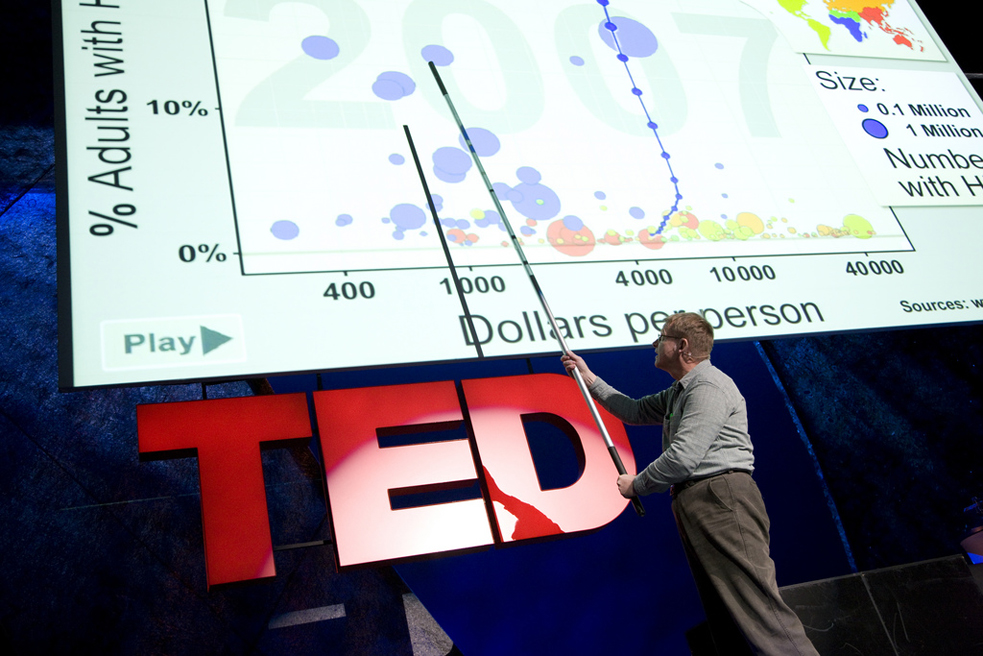
Hans Rosling has given nine TED Talks over the years. A website celebrates the anniversary of his first with a surprisingly hard quiz. Photo: Asa Mathat
Members of the TED community saturated the news in the past two weeks. Below, just a few of these headline-makers:
Eight years ago, Hans Rosling shared “The best stats you’ve ever seen” at TED2006, flipping our thinking on global health. BigThink.com is marking the anniversary of that talk. Take their very fun quiz that tests your understanding of population statistics, and then watch an hour-long talk from Rosling—given in May at the Nordic Media Festival—to check your answers. (And while you’re at it, watch all nine of Hans’ TED Talks. They are all fantastic.)
Dimitar Sasselov is the head of a Harvard team that has found a very surprising Earth-like planet—17 times the weight of Earth. Previously, it was assumed that planets any larger than about 10 times Earth’s weight would be gas giants, but this one, Kepler 10c, appears to have a rocky surface. Sasselov memorably calls it “the Godzilla of Earths.” (Watch Dimitar’s TED Talk, “How we found hundreds of potential Earth-like planets.”)
Sebastian Junger’s new documentary, Korengal, opened this weekend, in New York. Self-financed and self-released, the film is a follow-up to his Oscar-nominated documentary Restrepo. He tells us, “Restrepo was intended to give civilians an idea of what combat feels like; Korengal is meant to help soldiers and civilians understand the experience of war. How does fear work? What is courage? Why is it so hard for soldiers to come home?” (Read our Q&A with Sebastian and watch his talk, “Why veterans miss war.”)
Ed Yong explains why octopus arms don’t get tangled. (Watch his talk, “Suicidal crickets, zombie roaches and other parasite tales.”)
Alessandro Acquisti reacts to the revelation that the U.S.’s National Security Agency is collecting millions of images a day for use in facial recognition software. “There are still technical limitations on it,” Acquisti says, “but the computational power keeps growing, and the databases keep growing, and the algorithms keep improving.” (Watch his talk, “Why privacy matters.” See also: “The NSA responds to Edward Snowden’s TED Talk.”
Bertrand Piccard’s Solar Impulse 2 took its maiden flight today. In 2015, Piccard will pilot this solar-powered plane around the world. “It’s a great day for all the team,” Piccard told BBC News. Their only issue during the test flight? Some vibrations early on. (Read our Q&A with Bertrand or watch his talk, “My solar-powered adventure.”)
Seth Godin talked about his children’s book for adults, V Is for Vulnerable, in an interview at the HOW 2014 conference. Brainpickings captured the highlights of this conversation, in which he explains that the alphabet-book format was intended to get at “that part of your head that’s pre-cynical.” (Watch Seth’s talks, “The tribes we lead” and “How to get your ideas to spread.”)
In his quest to find genetic heroes, Stephen Friend published an article in Science right as his TED Talk was released last week. Both give different ways of understanding The Resilience Project, his effort to find those rare people who are at high genetic risk for a disease never actually develop it. (Watch Stephen’s talk, “The hunt for ‘unexpected genetic heroes.”)
Before becoming our Film + Video Editor, Isaac Wayton worked on the documentary Up Heartbreak Hill, about the young people of Navajo, New Mexico, who feel pulled between traditional life on the reservation and their desire to create better futures for themselves. The doc is streaming for free via PBS’ POV through June 4. The film will also show in Boston on June 7th, as part of the Runner’s World Heartbreak Hill Half & Festival.
And finally, Sebastian Seung’s profile in The New York Times call him the “prophet of the connectome.” The fascinating story dives into his latest paper and why, while it might not be what the public is hoping for, it is important nonetheless. (Watch his talk, “I am my connectome.”)
Comments (5)